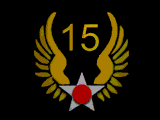|
|
Sgt. William J. Rossman Jr.
723rd Squadron
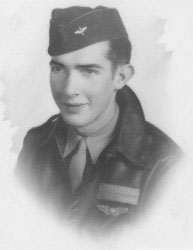
|
Mr. William J. Rossman, Jr., of Racine, Wisconsin, was recently awarded the Distinguished Flying Cross for exceptionally meritorious conduct and bravery
while participating in aerial flight during World War II. The prestigious award was for Mr. Rossman's act of extraordinary heroism 58 years ago, while serving as a
B-24 Aerial Gunner/Radio Operator at the rank of Staff Sergeant in the U.S. Army Air Corps.
On February 14, 1944, after bombing the marshalling yards at Verona, Italy, Sergeant Rossman's B-24 Liberator was hit by a fierce concentration of flak that knocked
out two of it's engines. Unable to keep up with the bomber formation, six Messerschmit ME-109's attacked the bomber, knocking out a third engine and started a fire.
The pilot, Lt. Robert Gernand, rang the alarm bell and ordered the crew to bail out. The bomber was in flames and falling in a tight spiral, losing altitude rapidly.
At a very low altitude and under a great deal of centrifugal force, the wounded Rossman remained aboard the flaming bomber with complete disregard for his own life to
assisted and bailout his severely wounded and immobile crew member, Sergeant Louis Vasquez.
|
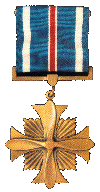
|
|
After bailing out himself, Rossman received care from the Italian Underground at a monastery in northern Italy until his capture by German SS troops ten days later.
He remained a Prisoner of War and spent time at four POW camps until his liberation in Bavaria by General Patton's 13th Armor Division in April 1945.
Rossman, who also received among other medals the Purple Heart, the Air Medal, and the POW medal, remained in the U.S. Air Force after World War II and was
married while attending Officer Candidate School on December 13, 1947.
In January 1949, 1st Lieutenant Rossman was discharged from the service after six years with the Army Air Corps and the U.S. Air Force. He returned to Racine
with his wife, Alice, where he worked as a manager at Metropolitan Life for 36 years until his retirement in 1986. They have one daughter, Pamela Hanson Melugin.
Mr. Rossman's heroic and selfless actions, above and beyond the call of duty, to rescue the life of his fellow crew member while facing great peril to his own, are truly
example for us all. Mr. Rossman is recognized as an outstanding citizen of his community, the State of Wisconsin, and the United States of America.
|
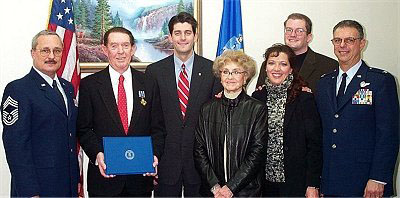
Article copied from the website of US Congressman Paul Ryan
|
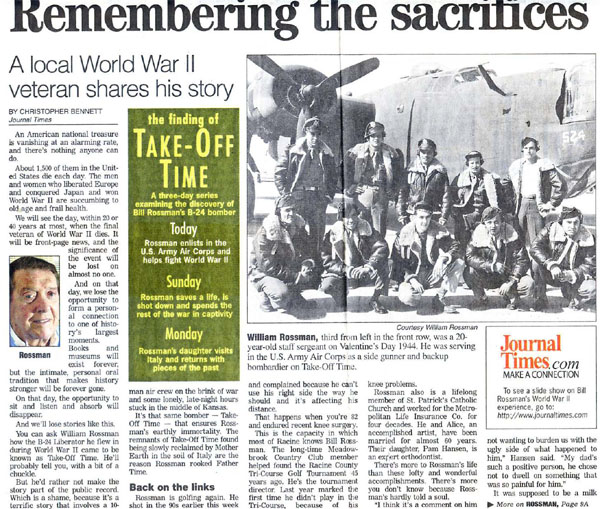
|

|
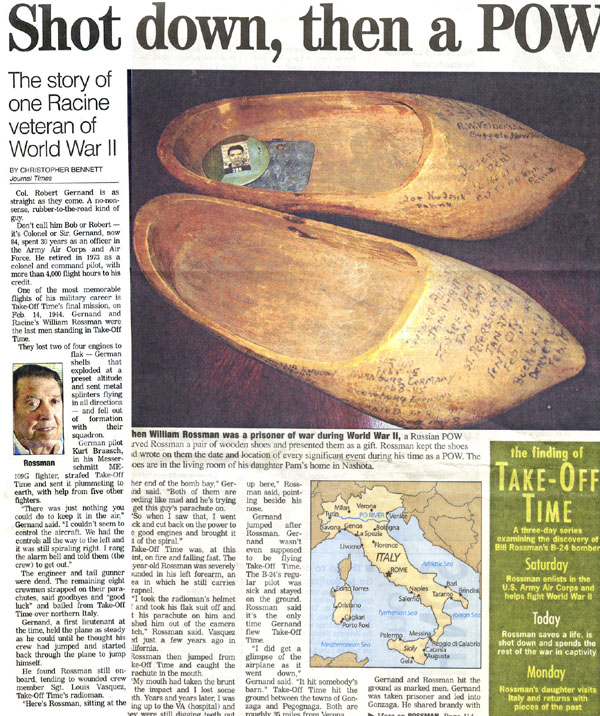
|
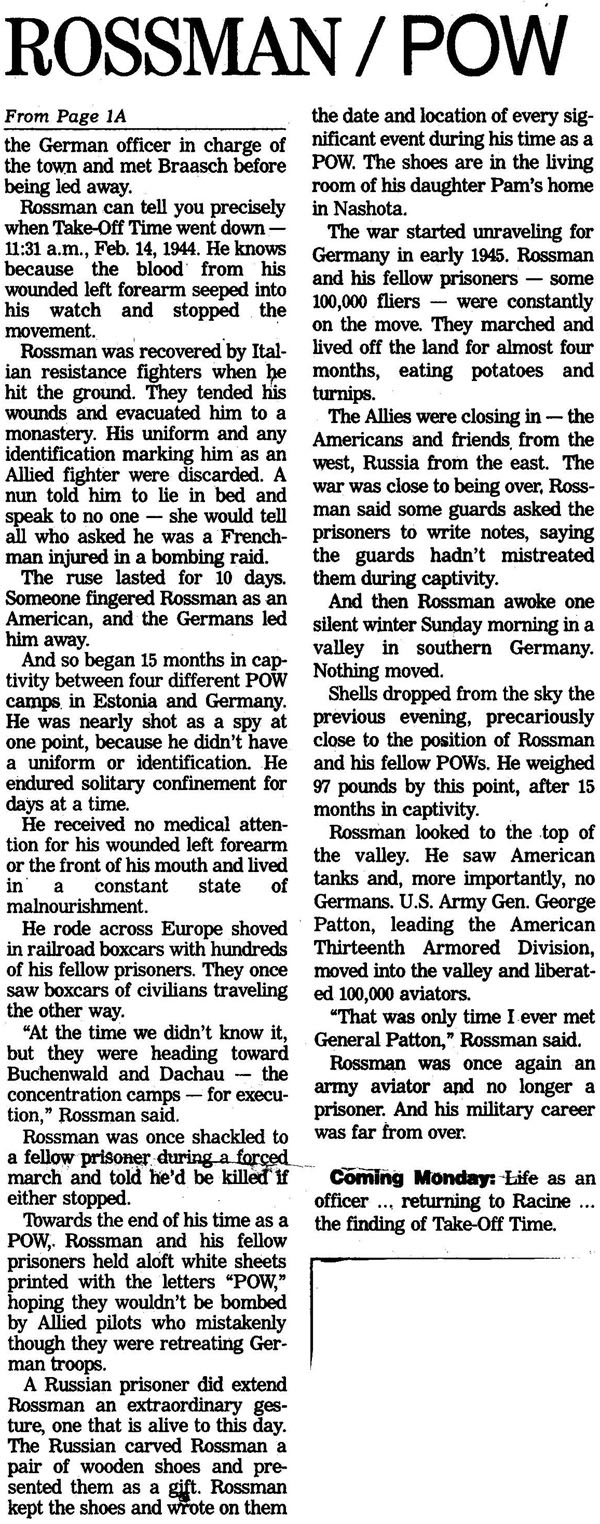
|
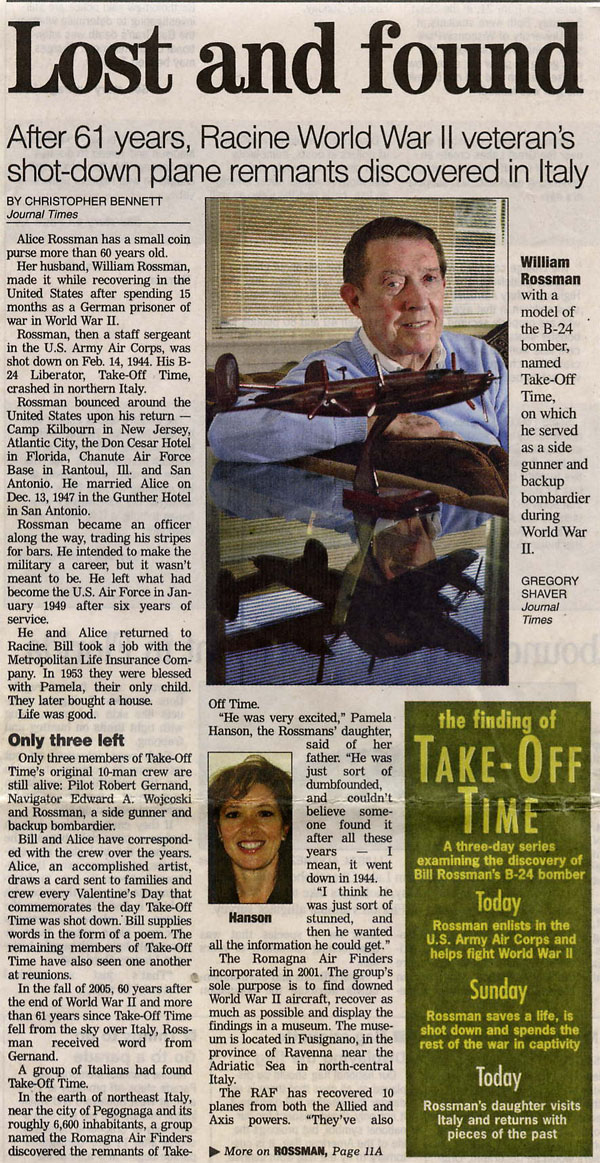
|
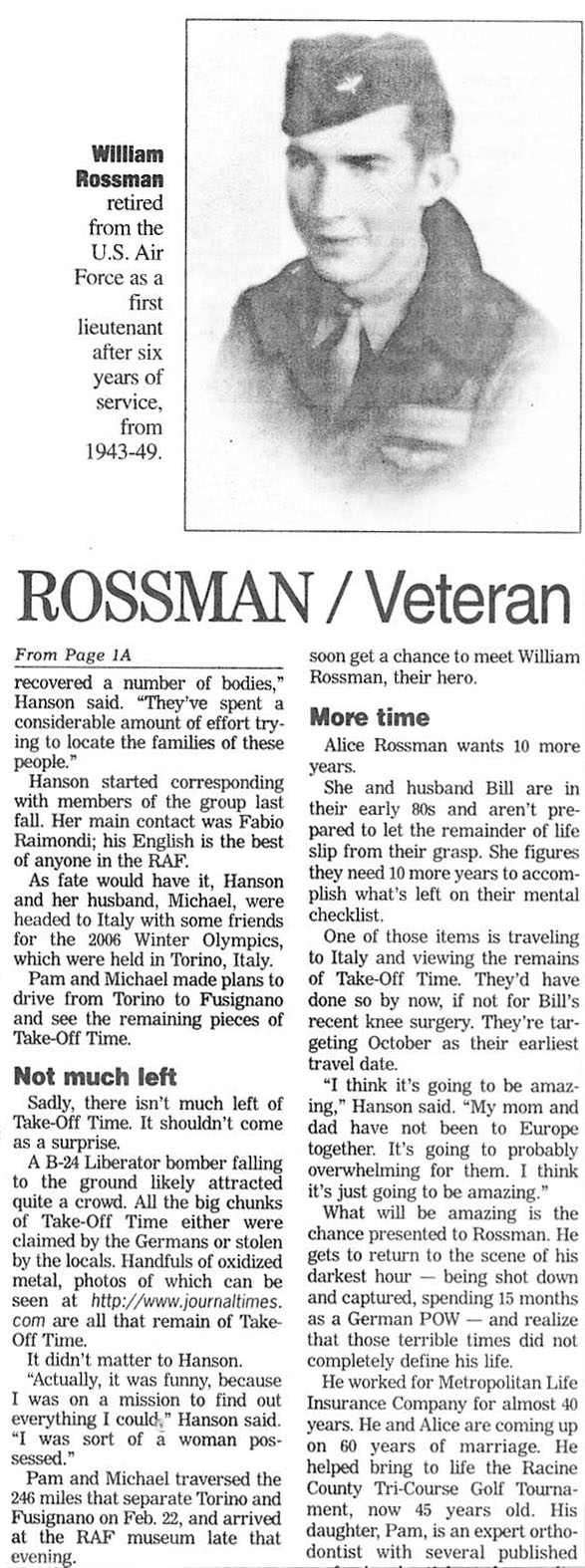
|
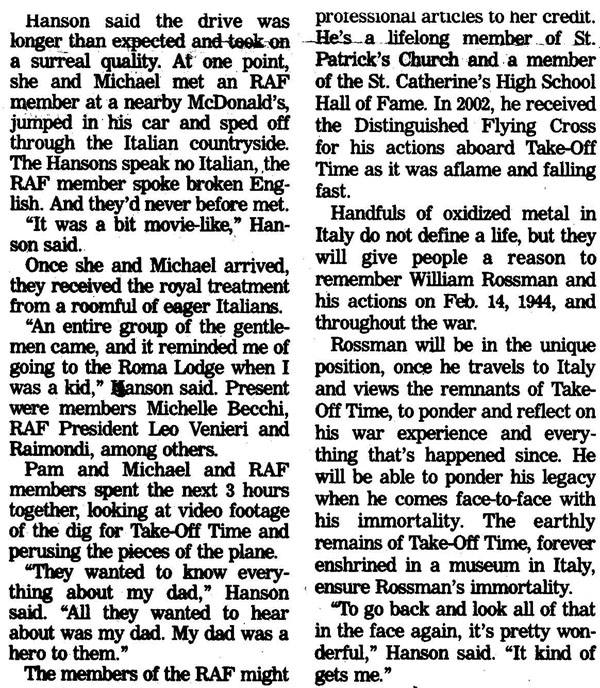
|
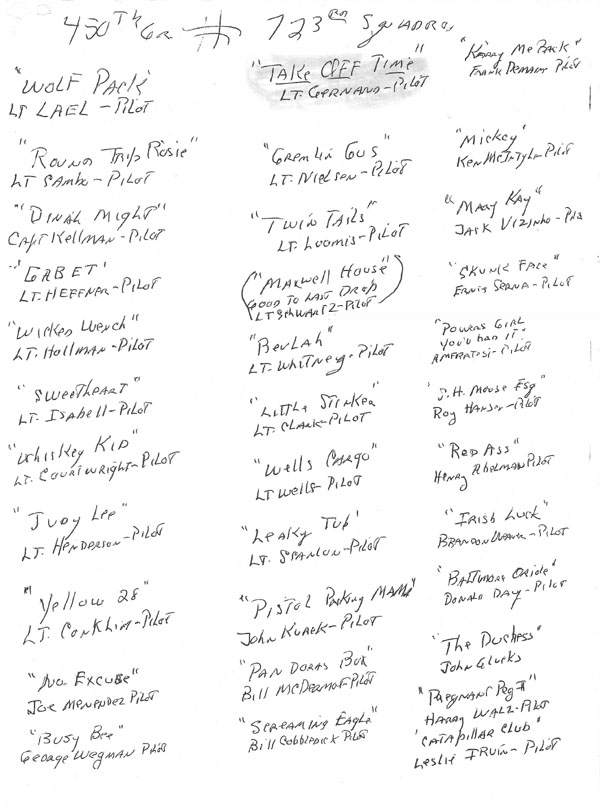
|
Shot down, then a POW
By Chris Bennett
Col. Robert Gernand is as straight as they come. A no-nonsense, rubber-to-the-road kind of guy.
Don't call him Bob or Robert - it's Colonel or Sir.
Gernand, now 84, spent 30 years as an officer in the Army Air Corps and Air Force. He retired in 1973 as a colonel and command pilot, with more than 4,000 flight hours to his credit.
One of the most memorable flights of his military career is Take-Off Time's final mission, on Feb. 14, 1944. Gernand and Racine's William Rossman were the last men standing in Take-Off Time.
They lost two of four engines to flak - German shells that exploded at a preset altitude and sent metal splinters flying in all directions - and fell out of formation with their squadron.
German pilot Kurt Braasch, in his Messerschmitt ME-109G fighter, strafed Take-Off Time and sent it plummeting to earth, with help from five other fighters.
"There was just nothing you could do to keep it in the air," Gernand said. "I couldn't seem to control the aircraft. We had the controls all the way to the left and it was still spiraling right. I rang the alarm bell and told them (the crew) to get out."
The engineer and tail gunner were dead. The remaining eight crewmen strapped on their parachutes, said goodbyes and "good luck" and bailed from Take-Off Time over northern Italy.
Gernand, a first lieutenant at the time, held the plane as steady as he could until he thought his crew had jumped and started back through the plane to jump himself.
He found Rossman still on-board, tending to wounded crew member Sgt. Louis Vasquez, Take-Off Time's radioman.
"Here's Rossman, sitting at the other end of the bomb bay," Gernand said. "Both of them are bleeding like mad and he's trying to get this guy's parachute on.
"So when I saw that, I went back and cut back on the power to the good engines and brought it out of the spiral."
Take-Off Time was, at this point, on fire and falling fast. The 20-year-old Rossman was severely wounded in his left forearm, an area in which he still carries shrapnel.
"I took the radioman's helmet off and took his flak suit off and got his parachute on him and pushed him out of the camera hatch," Rossman said. Vasquez died just a few years ago in California.
Rossman then jumped from Take-Off Time and caught the parachute in the mouth.
"My mouth had taken the brunt of the impact and I lost some teeth. Years and years later, I was going up to the VA (hospital) and they were still digging teeth out up here," Rossman said, pointing beside his nose.
Gernand jumped after Rossman. Gernand wasn't even supposed to be flying Take-Off Time. The B-24's regular pilot was sick and stayed on the ground. Rossman said it's the only time Gernand flew Take-Off Time.
"I did get a glimpse of the airplane as it went down," Gernand said. "It hit somebody's barn." Take-Off Time hit the ground between the towns of Gonzaga and Pegognaga. Both are roughly 35 miles from Verona.
Gernand and Rossman hit the ground as marked men. Gernand was taken prisoner and led into Gonzaga. He shared brandy with the German officer in charge of the town and met Braasch before being led away.
Rossman can tell you precisely when Take-Off Time went down - 11:31 a.m., Feb. 14, 1944. He knows because the blood from his wounded left forearm seeped into his watch and stopped the movement.
Rossman was recovered by Italian resistance fighters when he hit the ground. They tended his wounds and evacuated him to a monastery. His uniform and any identification marking him as an Allied fighter were discarded. A nun told him to lie in bed and speak to no one - she would tell all who asked he was a Frenchman injured in a bombing raid.
The ruse lasted for 10 days. Someone fingered Rossman as an American, and the Germans led him away.
And so began 15 months in captivity between four different POW camps in Estonia and Germany. He was nearly shot as a spy at one point, because he didn't have a uniform or identification. He endured solitary confinement for days at a time.
He received no medical attention for his wounded left forearm or the front of his mouth and lived in a constant state of malnourishment.
He rode across Europe shoved in railroad boxcars with hundreds of his fellow prisoners. They once saw boxcars of civilians traveling the other way.
"At the time we didn't know it, but they were heading toward Buchenwald and Dachau - the concentration camps - for execution," Rossman said.
Rossman was once shackled to a fellow prisoner during a forced march and told he'd be killed if either stopped.
Towards the end of his time as a POW, Rossman and his fellow prisoners held aloft white sheets printed with the letters "POW," hoping they wouldn't be bombed by Allied pilots who mistakenly though they were retreating German troops.
A Russian prisoner did extend Rossman an extraordinary gesture, one that is alive to this day. The Russian carved Rossman a pair of wooden shoes and presented them as a gift. Rossman kept the shoes and wrote on them the date and location of every significant event during his time as a POW. The shoes are in the living room of his daughter Pam's home in Nashota.
The war started unraveling for Germany in early 1945. Rossman and his fellow prisoners - some 100,000 fliers - were constantly on the move. They marched and lived off the land for almost four months, eating potatoes and turnips.
The Allies were closing in - the Americans and friends from the west, Russia from the east. The war was close to being over. Rossman said some guards asked the prisoners to write notes, saying the guards hadn't mistreated them during captivity.
And then Rossman awoke one silent winter Sunday morning in a valley in southern Germany. Nothing moved.
Shells dropped from the sky the previous evening, precariously close to the position of Rossman and his fellow POWs. He weighed 97 pounds by this point, after 15 months in captivity.
Rossman looked to the top of the valley. He saw American tanks and, more importantly, no Germans. U.S. Army Gen. George Patton, leading the American Thirteenth Armored Division, moved into the valley and liberated 100,000 aviators.
"That was only time I ever met General Patton," Rossman said.
Rossman was once again an army aviator and no longer a prisoner. And his military career was far from over.
Coming Monday: Life as an officer returning to Racine the finding of Take-Off Time.
Source Link
World War II heroism rewarded -- finally
BY ROB GOLUB, Journal Times, 3/26/02
RACINE -- Every so often, Bill Rossman thinks back to something he lived through in 1944 and he says to his wife, "If there was water down there, we wouldn't be here."
Rossman, 78, is thinking about the time he jumped out of a plane during World War II, hitting land -- not sea -- and getting captured by German soldiers.
It's amazing he survived 15 months in four prisoner of war camps. It's amazing he jumped out of a plane that was so shot up, two crewmen were killed and the craft was left spiraling downward. But what's most amazing is what he's won the Distinguished Flying Cross for -- staying aboard the sinking airship to help another crewman survive.
It seems nonsensical Army Air Corps regulations kept Rossman from getting the highly prestigious medal. But a change in the rules and some help from U.S. Rep. Paul Ryan, R-Janesville, will have the congressman presenting the award to Rossman in a ceremony Wednesday.
Rossman, a gunner, was on his 13th bombing mission aboard a B-24 bomber -- bombing railroad yards in Verona, Italy. Piloting the plane was retired Col. Robert H. Gernand, who was a first lieutenant at the time.
Gernand is an 81-year-old retiree who lives in St. Augustine, Fla. He still remembers a relatively loveless Valentine's Day in 1944, the day German ground guns and fighters ripped through three of his aircraft's engines, setting one on fire.
Gernand sounded the bail-out alarm, and most of the men who weren't killed by enemy fire parachuted out. But when Gernand left the cockpit to jump out himself, he saw Rossman struggling to assist an injured man who appeared to be in shock.
All the men wore heavy metal suits, to protect against enemy fire, and Rossman undressed the soldier so he could bail out. Once the weight was off the man, Rossman rolled him out the bomb bay doors. That soldier, Luis Vasquez, recovered enough to pull his parachute cord. He survived the war and died in California just a few years ago, Rossman said.
When Gernand saw this rescue in process he returned to the cockpit.
"He could see that I had to have some time," Rossman remembers. "He kept it level and steady as he could."
Rossman and Gernand jumped out safely, but they would spend 15 months under harsh Nazi rule in prison camps.
By the time Gernand was released and got around to thinking about Rossman for an award, more than two years had passed. Under the old rules, a Distinguished Flying Cross must be recommended within two years of the incident, by a senior officer who is present at the incident, Gernand said.
But how are you supposed to recommend someone while you're in a prisoner of war camp?
"It was a Catch-22," Gernand said. "In the paper about 55 or 56 years later, I see this thing that they had opened it up again if the recommendation was made by an officer and made to the congressman."
Rossman survived a harsh captivity, including being transported with other prisoners stuffed into railroad box cars. Meanwhile, his Racine mother made daily visits to St. Patrick's Congregation, 1100 Erie St., to pray for the St. Catherine's High School graduate.
After General Patton's 13th armored division liberated his camp in Bavaria, Rossman eventually left the service as a first lieutenant. He came home to work for Metropolitan Life Insurance in Racine from 1950 to 1986. He will add his Distinguished Flying Cross to the Purple Heart and prisoner of war medal he already has.
Alice and Bill Rossman have been married for 54 years. Their daughter and son-in-law, Pamela Hanson Melugin and Michael Melugin, live in Nashotah.
Source Link
Lost and found -- After 61 years, Racine World War II veteran's shot-down plane remnants discovered in Italy
By Chris Bennett
Alice Rossman has a small coin purse more than 60 years old.
Her husband, William Rossman, made it while recovering in the United States after spending 15 months as a German prisoner of war in World War II.
Rossman, then a staff sergeant in the U.S. Army Air Corps, was shot down on Feb. 14, 1944. His B-24 Liberator, Take-Off Time, crashed in northern Italy.
Rossman bounced around the United States upon his return - Camp Kilbourn in New Jersey, Atlantic City, the Don Cesar Hotel in Florida, Chanute Air Force Base in Rantoul, Ill. and San Antonio. He married Alice on Dec. 13, 1947 in the Gunther Hotel in San Antonio.
Rossman became an officer along the way, trading his stripes for bars. He intended to make the military a career, but it wasn't meant to be. He left what had become the U.S. Air Force in January 1949 after six years of
service.
He and Alice returned to Racine. Bill took a job with the Metropolitan Life Insurance Company. In 1953 they were blessed with Pamela, their only child. They later bought a house.
Life was good.
Only three left Only three members of Take-Off Time's original 10-man crew are still alive: Pilot Robert Gernand, Navigator Edward A. Wojcoski and Rossman, a side gunner and backup bombardier.
Bill and Alice have corresponded with the crew over the years. Alice, an accomplished artist, draws a card sent to families and crew every Valentine's Day that commemorates the day Take-Off Time was shot down. Bill supplies words in the form of a poem. The remaining members of Take-Off Time have also seen one another at reunions.
In the fall of 2005, 60 years after the end of World War II and more than 61 years since Take-Off Time fell from the sky over Italy, Rossman received word from
Gernand.
A group of Italians had found Take-Off Time.
In the earth of northeast Italy, near the city of Pegognaga and its roughly 6,600 inhabitants, a group named the Romagna Air Finders discovered the remnants of Take-Off Time.
"He was very excited," Pamela Hanson, the Rossmans' daughter, said of her father. "He was just sort of dumbfounded, and couldn't believe someone found it after all these years - I mean, it went down in 1944.
"I think he was just sort of stunned, and then he wanted all the information he could get."
The Romagna Air Finders incorporated in 2001. The group's sole purpose is to find downed World War II aircraft, recover as much as possible and display the findings in a museum. The museum is located in Fusignano, in the province of Ravenna near the Adriatic Sea in north-central Italy.
The RAF has recovered 10 planes from both the Allied and Axis powers. "They've also
recovered a number of bodies," Hanson said. "They've spent a considerable amount of effort trying to locate the families of these people."
Hanson started corresponding with members of the group last fall. Her main contact was Fabio Raimondi; his English is the best of anyone in the RAF.
As fate would have it, Hanson and her husband, Michael, were headed to Italy with some friends for the 2006 Winter Olympics, which were held in Torino, Italy.
Pam and Michael made plans to drive from Torino to Fusignano and see the remaining pieces of Take-Off Time.
Not much left Sadly, there isn't much left of Take-Off Time. It shouldn't come as a surprise.
A B-24 Liberator bomber falling to the ground likely attracted quite a crowd. All the big chunks of Take-Off Time either were claimed by the Germans or stolen by the locals. Handfuls of oxidized metal, photos of which can be seen at http://www.journaltimes.
com are all that remain of Take-Off Time.
It didn't matter to Hanson.
"Actually, it was funny, because I was on a mission to find out everything I could," Hanson said. "I was sort of a woman possessed."
Pam and Michael traversed the 246 miles that separate Torino and Fusignano on Feb. 22, and arrived at the RAF museum late that evening.
Hanson said the drive was longer than expected and took on a surreal quality. At one point, she and Michael met an RAF member at a nearby McDonald's, jumped in his car and sped off through the Italian countryside. The Hansons speak no Italian, the RAF member spoke broken English. And they'd never before met.
"It was a bit movie-like," Hanson said.
Once she and Michael arrived, they received the royal treatment from a roomful of eager Italians.
"An entire group of the gentlemen came, and it reminded me of going to the Roma Lodge when I was a kid," Hanson said. Present were members Michelle Becchi, RAF President Leo Venieri and Raimondi, among others.
Pam and Michael and RAF members spent the next 3 hours together, looking at video footage of the dig for Take-Off Time and perusing the pieces of the plane.
"They wanted to know everything about my dad," Hanson said. "All they wanted to hear about was my dad. My dad was a hero to them."
The members of the RAF might soon get a chance to meet William Rossman, their hero.
More time Alice Rossman wants 10 more years.
She and husband Bill are in their early 80s and aren't prepared to let the remainder of life slip from their grasp. She figures they need 10 more years to accomplish what's left on their mental checklist.
One of those items is traveling to Italy and viewing the remains of Take-Off Time. They'd have done so by now, if not for Bill's recent knee surgery. They're targeting October as their earliest travel date.
"I think it's going to be amazing," Hanson said. "My mom and dad have not been to Europe together. It's going to probably overwhelming for them. I think it's just going to be amazing."
What will be amazing is the chance presented to Rossman. He gets to return to the scene of his darkest hour - being shot down and captured, spending 15 months as a German POW - and realize that those terrible times did not completely define his life.
He worked for Metropolitan Life Insurance Company for almost 40 years. He and Alice are coming up on 60 years of marriage. He helped bring to life the Racine County Tri-Course Golf Tournament, now 45 years old. His daughter, Pam, is an expert orthodontist with several published professional articles to her credit. He's a lifelong member of St. Patrick's Church and a member of the St. Catherine's High School Hall of Fame. In 2002, he received the Distinguished Flying Cross for his actions aboard Take-Off Time as it was aflame and falling fast.
Handfuls of oxidized metal in Italy do not define a life, but they will give people a reason to remember William Rossman and his actions on Feb. 14, 1944, and throughout the war.
Rossman will be in the unique position, once he travels to Italy and views the remnants of Take-Off Time, to ponder and reflect on his war experience and everything that's happened since. He will be able to ponder his legacy when he comes face-to-face with his immortality. The earthly remains of Take-Off Time, forever enshrined in a museum in Italy, ensure Rossman's immortality.
"To go back and look all of that in the face again, it's pretty wonderful," Hanson said. "It kind of gets me."
Source Link
|
Link To Crew Information
Link To Additional Crew Information
Link To Other Information
|
